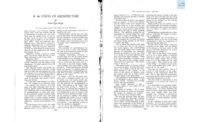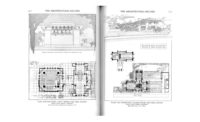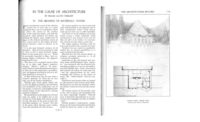The exteriors of these structures will receive less ready recognition perhaps than the interiors, and because they are the result of a radically different conception as to what should constitute a building. We have formed a habit of mind concerning architecture to which the expression of most of these exteriors must be a shock, at first more or less disagreeable, and the more so as the habit of mind is more narrowly fixed by so-called classic training. Simplicity is not in itself an end; it is a means to an end. Our aesthetics are dyspeptic from incontinent indulgence in "Frenchite" pastry. We crave ornament for the sake of ornament; cover up our faults of design with ornamental sensualities that were a long time ago sensuous ornament. We will do well to dismiss this unwholesome and unholy craving and look to the simple line; to the clean though living form and quiet color for a time, until the true significance of these things has dawned for us once more. The old structural forms which up to the present time, have spelled "architecture" are decayed. Their life went from them long ago and new conditions industrially, steel and concrete and terra-cotta in particular, are prophesying a more plastic art wherein as the flesh is to our bones so will the covering be to the structure, but more truly and beautifully expressive than ever. But that is a long story This reticence in the matter of ornamentation is characteristic of structures and for at least two reasons: first, they are the expression of an idea that the ornamentation of a building should be constitutional, a matter of the nature of the structure beginning with the ground plan. In the buildings themselves, in the sense of the whole there is lacking neither richness nor incident but their qualities are secured not by applied decoration, they are found in the fashioning of the whole, in which color, too, plays as significant a part as it does in an old, Japanese woodblock print. Second: because as before stated: buildings perform their highest function in relation to human life within and the natural efflorescence without; and to develop and maintain the harmony of a true chord between them making of the building in this sense a sure foil for life, broad, simple surfaces and highly conventionalized forms are inevitable. These ideals take the buildings out of school and marry them to the ground; make them intimate expressions or revelations of the exteriors, individualize them regardless of preconceived notions of style. I have tried to make their grammar perfect in its way and to give their forms and proportions an integrity that will bear study, although few of them can be intelligently studied apart from their environment. So, what might be termed the democratic character of the exteriors is their first undefined offence-the lack, wholly, of what the professional critic would deem architecture; in fact, most of the critic's architecture has been left out.
There is always a synthetic basis for the features of the various structures, and consequently a constantly accumulating residue of formulas, which becomes more and more useful; but I do not pretend to say that the perception or conception of them was not at first intuitive, or that those that lie yet beyond will not be grasped in the same intuitive way; but, after all, architecture is a scientific art, and the thinking basis will ever be for the architect his surety, the final court in which his imagination sifts his feelings.
The few draughtsmen so far associated with this work have been taken into the draughting room, in every case almost wholly unformed, many of them with no particular previous training and patiently nursed for years in the atmosphere of the work itself until saturated by intimate association, at an impressionable age, with its motifs and phases, they have become helpful. To develop the sympathetic grasp of detail that is necessary before this point is reached has proved usually a matter of years, with little advantage on the side of the college trained understudy. These young people have found their way to me through natural sympathy with the work and have become loyal assistants. The members, so far, all told here and elsewhere, of our little university of fourteen years standing are: Marion Mahony, a capable assistant for eleven years: William Drummond, seven years; Francis Byrne, five years; Isabel Roberts, five years; George Willis, four years; Walter Griffin, four years; Andrew Willatzon, three years; Charles E. White, Jr., one year; Erwin Barglebaugh and Robert Hardin, each one year; Albert McArthur, entering.
Others have been attracted by what seemed to them to be the novelty of the work, staying only long enough to acquire a smattering of form, then departing to sell a superficial proficiency elsewhere. Still others shortly develop a mastery of the subject, discovering that it is all just as they would have done it, anyway, and, chafing at the unkind fate that forestalled them in its practice, resolve to blaze a trail for themselves without further loss of time. It is urged against the more loyal that they are sacrificing their individuality to that which has dominated this work; but it is too soon to impeach a single understudy on this basis, for, although they will inevitably repeat for years the methods, forms, and habit of thought, even the mannerisms of the present work, if there is virtue in the principles behind it that virtue will stay with them through the preliminary stages of their own practice until their own individualities truly develop independently. I have noticed that those who have made the most fuss about their "individuality" in early stages, those who took themselves most seriously in that regard, were inevitably those who had least.
Many elements of Mr. Sullivan's personality in his art-what might be called his mannerisms-naturally enough clung to my work in the early years and may be readily traced by the casual observer, but for me one real proof of the virtue inherent in this work will lie in the fact that some of the young men and women who have given themselves up to me so faithfully these past years will some day contribute rounded individualities of their own and forms of their own devising to the new school.
This year, I assign to each a project that has been carefully conceived in my own mind, which he accepts as a specific work. He follows its subsequent development through all its phases in drawing room and field meeting with the client himself on occasion, gaining an all-round development impossible otherwise, and insuring an enthusiasm and a grasp of detail decidedly to the best interest of the client. These privileges in the hands of selfishly ambitious or overconfident assistants would soon wreck such a system; but I can say that among my own boys it has already proved a moderate success, with every prospect of being continued as a settled policy in future.
Nevertheless, I believe that only when one individual forms the concept of the various projects and also determines the character of every detail in the sum total, even to the size and shape of the pieces of glass in the windows, the arrangement and profile of the most insignificant of the architectural members, will that unity be secured which is the soul of the individual work of art. This means that fewer buildings should be entrusted to one architect. His output will of necessity be relatively small-small that is, as compared to the volume of work turned out in any one of fifty "successful offices" in America. I believe there is no middle course worth considering in the fight of the best future of American architecture. With no more propriety can an architect leave the details touching the form of his concept to assistants, no matter how sympathetic and capable they may be, than can a painter entrust the painting in of the details of his picture to a pupil; for an architect who would do individual work must have a technique well developed and peculiar to himself which, if he is fertile, is still growing with his growth. To keep everything "in place" requires constant care and study in matters that the old-school practitioner would scorn to touch.
As for the future the work shall grow more truly simple; more expressive with fewer lines, fewer forms; more articulate with less labor, more plastic, more fluent, although more coherent; more organic. It shall grow not only to fit more perfectly the methods and procure that are called upon to produce it, but shall further find whatever is lovely or of good repute in method or process, and idealize it with the cleanest most virile stroke I can imagine. As understanding and appreciation of life matures and deepens, this work shall prophesy and idealize the character of the individual it is fashioned to serve more intimately, no matter how inexpensive the result must finally be. It shall become in its atmosphere as pure and elevating in its humble way as the trees and flowers are in their perfectly appointed way, for only so can architecture be worthy in high rank as a fine art, or the architect discharge the obligation he assumes to the public-imposed upon him by the nature of his own profession.








Post a comment to this article
Report Abusive Comment